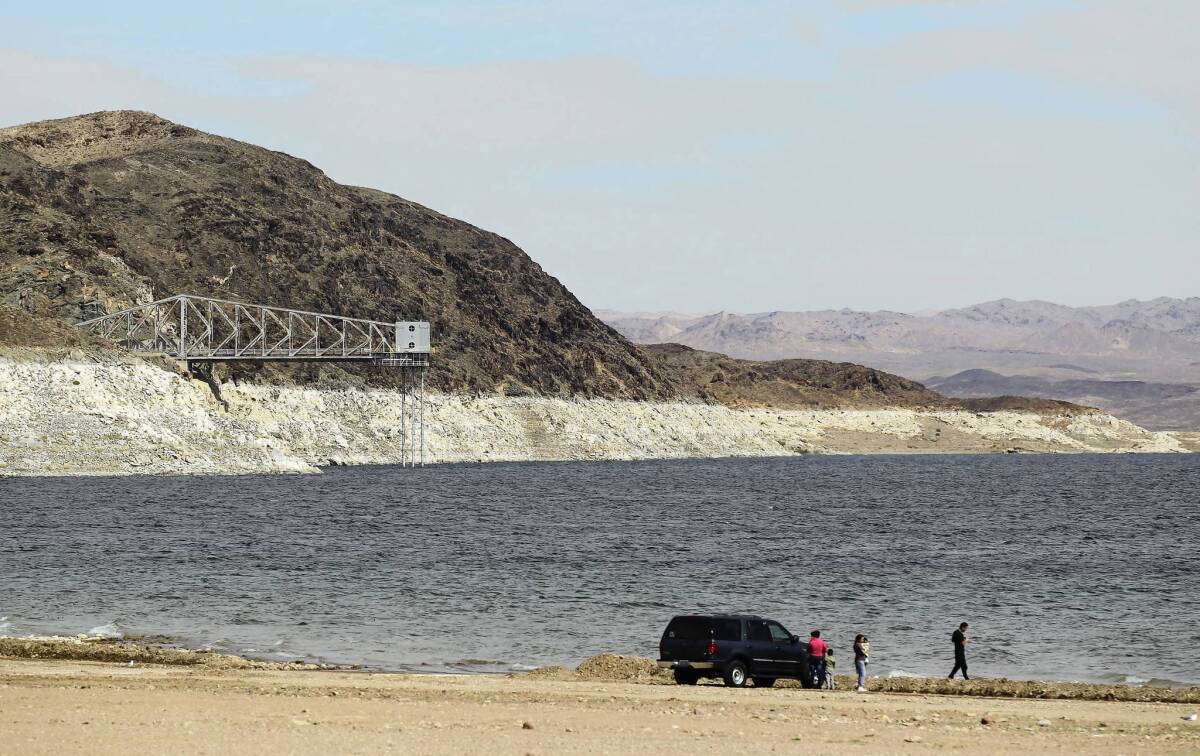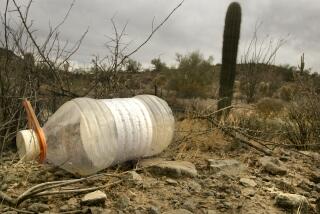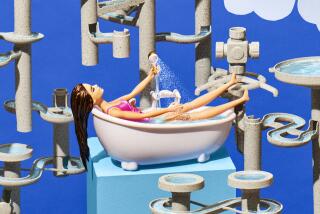America’s water mirage

- Share via
On an unseasonably hot morning this fall, my 11-year-old son and I set off for Hoover Dam, his first time to tour the American engineering wonder that draws nearly 1 million visitors a year.
In recent years, I’d visited the dam and adjacent reservoir, Lake Mead, as a journalist who reports on water. But I hadn’t been there as a tourist since my own childhood. I looked forward to hearing how the dam’s minder, the U.S. Bureau of Reclamation, would tell such a big story to such a big audience.
I expected to hear about the drama, human sacrifice and technical prowess behind the dam’s construction. I also expected some of the growing concerns about the Colorado River that feeds the dam, having seen the bureau’s worrisome charts that show how demand for the water shared by seven U.S. states and Mexico has exceeded supply — a gap growing ever wider amid epic drought and epic waste.
Americans operate under an illusion of water abundance. That fiction makes the reality of water scarcity a particularly hard concept to get across. From California to Florida, freshwater aquifers are being pumped so much faster than they recharge that many parts of the country can no longer rely on groundwater to supply future populations.
But we can’t see dried-out aquifers the way we could see black Dust Bowl storms in the 1930s or water pollution in the early 1970s. So we still pump with abandon to do things like soak the turf grass that covers 63,240 square miles of the nation. We flush toilets with this same fresh, potable water, after treating it at great expense to meet government standards for drinking.
We fill the fridge with beef, the shopping bags with cotton T’s, the gas tank with corn-made ethanol — all with little inkling of how we’re draining to extinction the Ogallala aquifer that irrigates a quarter of the nation’s agricultural harvest. Water authority members who oversee the Ogallala and farmers who pump it have a chilling term for its use: “managed depletion.” Your guess is as good as theirs where the staples will come from when the depletion is done.
Overtapped rivers are likewise out of sight for most people, who may encounter the source of their shower only as they drive by a carefully managed reservoir. Since Georgia’s Lake Lanier, managed by the U.S. Army Corps of Engineers, is holding Chattahoochee River water again, Atlantans can turn on the lawn sprinklers, never having to think about how that action is wiping out an oyster fishery, and a way of life, downstream in Apalachicola, Fla.
But Lake Mead is different. It’s one of the few places in the United States where the illusion of water abundance is being exposed for what it is: a beautiful bubble doomed to pop, just like other great national illusions — the unending bull market, say, or upward-only housing prices.
For 12 years, the nation’s largest reservoir has dropped steadily to reveal a calcium-carbonate bathtub ring, evidence of human folly and nature’s frailty — the over-allocation of the Colorado River and the drought still battering so much of the United States.
The chalky, ever-widening ring is the perfect starting point to talk to the millions who show up at Hoover Dam about our need to live differently with water.
Instead, the hourlong tour that my son and I took was as whitewashed as Mead’s bathtub ring. It began with a film describing the system as an “assured and reliable water supply” for Southwestern cities and farms. Then, two guides led our attentive group on a bullish circuit of the generating plant and dam. Their only mention of the ring brushed it off as a high-water mark left from the Colorado River’s 1983 flood, a compelling story that ended with the dam’s heroic success in containing the swollen river nearly 30 years ago.
They uttered not one word about the dramatic drought that has unfolded since, much less what the widening bathtub ring portends for the future of the arid Southwest.
This is the illusion of water abundance at its most obscene. The water sector and large water users are so adept at capturing water and moving it around our cities and regions that the average American never has to worry about how it all works — until it doesn’t, just like credit default swaps or too-big-to-fail banks.
The conveyance of clean water into our cities, and the movement of wastewater out, was among the greatest scientific achievements of the 20th century, one that saved countless lives. But now that achievement has metastasized into an unsustainable entitlement. As cheap water flows from our taps like magic, our freshwaters have become the single most degraded of America’s major resources, identified by the USGS and other agencies as having lost a greater portion of their species and habitat than land ecosystems.
More than any other factor, human use of that freshwater — for agricultural irrigation, energy production and water for our homes and businesses — is to blame. And yet, from Australia to Texas, people and businesses are proving how painless it is to live with a lot less water.
In Australia, the backyard rainwater tank has become so ubiquitous that Australian Geographic named it one of its “100 Aussie icons,” right up there with the boomerang and the didgeridoo. The water revolution Down Under is not about mega-technologies such as desalination plants but tiny technologies such as micro-irrigation for agriculture and waterless everything — waterless urinals, waterless carwashes, even waterless woks in the Chinese restaurants.
Texans in San Antonio have cut their water use in half, mostly by breaking off their love affair with the lawn. In parched north and west Texas, cattle operations such as Dixon Ranches are figuring out how to raise livestock on nonirrigated grasslands by mimicking the historic grazing patterns of Plains bison.
Still, the illusion of water abundance blinds most of the nation to all the good reasons why we should be doing all of that and more.
As with the financial and housing illusions, government water managers and the largest private water users are often too mesmerized by their own mirage to help the rest of us see the threats to U.S. aquifers and rivers. From the docents at the Hoover Dam to the biggest users to our own, overwatered backyards, let’s break that cycle — and stem the drain on America’s water resources before it’s too late.
Cynthia Barnett is a journalist and the author of “Blue Revolution: Unmaking America’s Water Crisis,” which calls for a water ethic for the nation.
More to Read
A cure for the common opinion
Get thought-provoking perspectives with our weekly newsletter.
You may occasionally receive promotional content from the Los Angeles Times.










